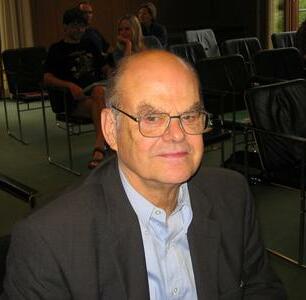Related Research Articles

George Pólya was a Hungarian-American mathematician. He was a professor of mathematics from 1914 to 1940 at ETH Zürich and from 1940 to 1953 at Stanford University. He made fundamental contributions to combinatorics, number theory, numerical analysis and probability theory. He is also noted for his work in heuristics and mathematics education. He has been described as one of The Martians, an informal category which included one of his most famous students at ETH Zurich, John von Neumann.

George Bernard Dantzig was an American mathematical scientist who made contributions to industrial engineering, operations research, computer science, economics, and statistics.
Paul Joseph Cohen was an American mathematician. He is best known for his proofs that the continuum hypothesis and the axiom of choice are independent from Zermelo–Fraenkel set theory, for which he was awarded a Fields Medal.

Stephen Arthur Cook is an American-Canadian computer scientist and mathematician who has made significant contributions to the fields of complexity theory and proof complexity. He is a university professor emeritus at the University of Toronto, Department of Computer Science and Department of Mathematics.

Leonid Vitalyevich Kantorovich was a Soviet mathematician and economist, known for his theory and development of techniques for the optimal allocation of resources. He is regarded as the founder of linear programming. He was the winner of the Stalin Prize in 1949 and the Nobel Memorial Prize in Economic Sciences in 1975.

Sir John Edward Lennard-Jones was a British mathematician and professor of theoretical physics at the University of Bristol, and then of theoretical science at the University of Cambridge. He was an important pioneer in the development of modern computational chemistry and theoretical chemistry.

John Griggs Thompson is an American mathematician at the University of Florida noted for his work in the field of finite groups. He was awarded the Fields Medal in 1970, the Wolf Prize in 1992, and the Abel Prize in 2008.
Masayoshi Nagata was a Japanese mathematician, known for his work in the field of commutative algebra.

Michael Fredric Sipser is an American theoretical computer scientist who has made early contributions to computational complexity theory. He is a professor of applied mathematics and was the dean of science at the Massachusetts Institute of Technology.

Elliott Waters Montroll was an American scientist and mathematician.
James Burton Ax was an American mathematician who made groundbreaking contributions in algebra and number theory using model theory. He shared, with Simon B. Kochen, the seventh Frank Nelson Cole Prize in Number Theory, which was awarded for a series of three joint papers on Diophantine problems.

T. V. Raman is a computer scientist who specializes in accessibility research. His research interests are primarily in the areas of auditory user interfaces and structured electronic documents. He has worked on speech interaction and markup technologies in the context of the World Wide Web at Digital's Cambridge Research Lab (CRL), Adobe Systems and IBM Research. He currently works at Google Research. Raman has himself been partially sighted since birth, and blind since the age of 14.

A dynamo is an electrical generator that creates direct current using a commutator. Dynamos were the first electrical generators capable of delivering power for industry, and the foundation upon which many other later electric-power conversion devices were based, including the electric motor, the alternating-current alternator, and the rotary converter.

George Piranian was a Swiss-American mathematician. Piranian was internationally known for his research in complex analysis, his association with Paul Erdős, and his editing of the Michigan Mathematical Journal.
Michel George Malti was an American electrical engineer, known for his work in circuit analysis. He was born in Deir el Qamar, in modern-day Lebanon and died in Miami, Florida. He graduated from the Syrian Protestant college (1915) and from Georgia Tech (1922), before joining Cornell University as an instructor and student, earning a M.Sc. (1924) and Ph.D. (1927), all degrees in electrical engineering.

Arthur Byron Coble was an American mathematician. He did research on finite geometries and the group theory related to them, Cremona transformations associated with the Galois theory of equations, and the relations between hyperelliptic theta functions, irrational binary invariants, the Weddle surface and the Kummer surface. He was President of the American Mathematical Society from 1933 to 1934.

Paul Olum was an American mathematician, professor of mathematics, and university administrator.

Sergei Nikolaevich Artemov is a Russian-American researcher in logic and its applications. He currently holds the title of Distinguished Professor at the Graduate Center of the City University of New York where he is the founder and head of its research laboratory for logic and computation. His research interests include proof theory and logic in computer science, optimal control and hybrid systems, automated deduction and verification, epistemology, and epistemic game theory. He is best known for his invention of logics of proofs and justifications.

Fernando Codá dos Santos Cavalcanti Marques is a Brazilian mathematician working mainly in geometry, topology, partial differential equations and Morse theory. He is a professor at Princeton University. In 2012, together with André Neves, he proved the Willmore conjecture. Since then, among proving other important conjectures, Marques and Neves greatly extended Almgren–Pitts min-max theory to prove theorems about minimal surfaces.
Clarence Floyd Hirshfeld was an American electrical, mechanical and consulting engineer, educator, chief of research for the Detroit Edison Co., now DTE Electric Company, author, and inventor, who was awarded the John Fritz Medal posthumously in 1940.
References
- ↑ Notices of the American Mathematical Society, vol. 49, no. 6, p.694 (2002)
- ↑ entry at Mathematics Genealogy Project
- ↑ "DYNAMO 'BALANCE' FOUND AT CORNELL; Problem Left by Faraday Is Solved ..." New York Times . 13 March 1939. Retrieved 2008-06-27.
- ↑ "Cornell Scientists Find New Way to 'Balance' Dynamos". Washington Post . 13 March 1939. Archived from the original on January 31, 2013. Retrieved 2008-06-27.